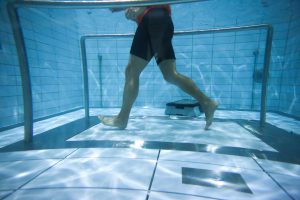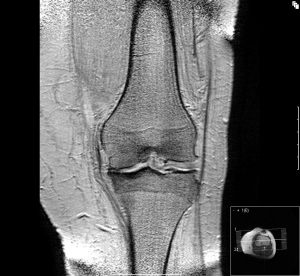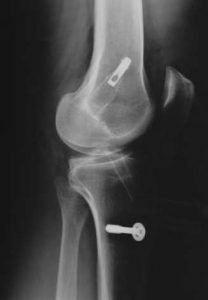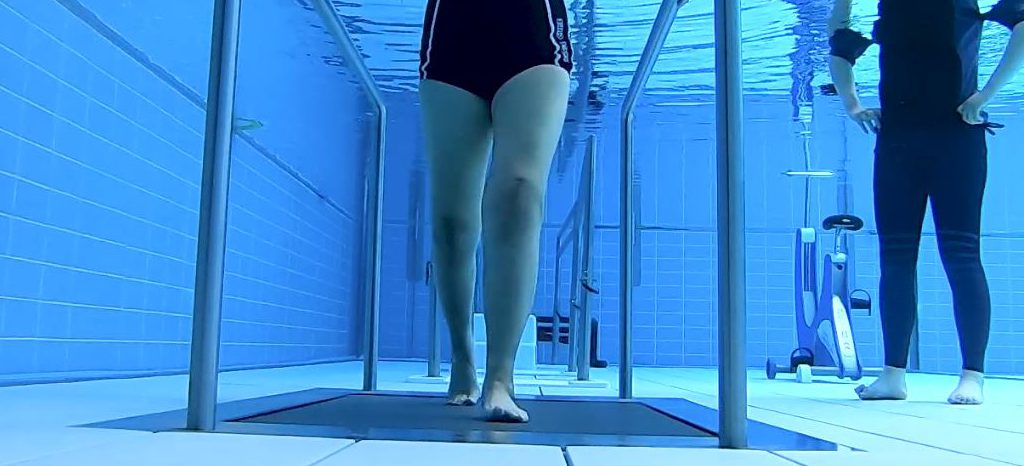General Aquatic therapy can be very beneficial for orthopedic patients, as water immersion, by itself delivers the following benefits:
- Decreased axial joint loading due to buoyancy
- Increased flexibility and range of motion (ROM) as variations in hydrostatic pressure change viscosity of of the extracellular matrix
- Decreased nociception because of activation of mechanoreceptors due to turbulent flow
- Resistance to movement, increasing muscle endurance
- Possibility to create unexpected perturbations with currents, training equilibrium reactions
- Increased cardiac efficiency (a better rate*pressure product) due to increased central blood volume with lower afterload, from static pressure effects of the water.
- Stimulation of the spinal motor pattern generator by imposing continuing cyclic movements
- Possibility to train gait variability by quick speed adjustments
Being able to change the depth of the pool, for instance using a movable pool floor, increases the treatment possibilities tremendously, as the therapist can now determine the intensity of joint loading according to the needs of the patient.
The next step in this progression is the aquatic underwater treadmill. An underwater treadmill facilitates walking exercises, while at the same time the patient stays in the same place, and therefore, the therapist can observe the patient accurately using camera’s. In this way, gait can be corrected and specific muscle groups can be selectively strengthened to provide just the right amount of correction.
An underwater treadmill in the pool adds a multitude of extra treatment possibilities, whether for neurological, metabolic, geriatric or orthopedic patients.
In this article, we will review a series of articles about the application of the underwater treadmill in the field of orthopedics.

Osteoarthritis
There is good evidence that Aquatic treadmill exercise has a positive effect on patients with Osteoarthritis of the knee. Three articles in particular conclude that an aquatic underwater treadmill is a useful tool for patients with Osteoarthritis:
A 2014 Bressel, Wing, Miller, Dolny
B 2013 Roper, Bressel, Tillman
C 2010 Denning, Bressel, Dolny
(full reference at the bottom of this article)
Tot start with article C (2010), this is a study of 19 participants diagnosed with Osteoarthritis where the acute effects were measured of exercising on an underwater treadmill, on Oxygen consumption, perceived pain and mobility. Here it was concluded that “Patients diagnosed with Osteoarthritis may walk on an underwater treadmill at a moderate intensity with less pain and equivalent energy expenditures compared with walking on a land based treadmill.” Also, the article concludes that “patients with Osteoarthritis may receive the same aerobic conditioning during underwater treadmill exercise with less joint pain than performing the same exercises on land.”

Article B (2013), is a study of 14 subjects, aged 43-64 years of age, diagnosed with Osteoarthritis of the knee, or knee and ankle or hip. Gait kinematics and pain were measured before and after each intervention. Here it was concluded that “The angular velocity gain score during stance for left knee extension was improved by 38% after aquatic treadmill exercise. Similarly, during swing, the gain scores for angular velocity were also greater the left knee internal rotation and extension by 65% and 20%.” Also, “Perceived pain was 100% greater after land that aquatic treadmill exercise.” Therefore the researchers conclude that “An acute training period on an aquatic treadmill positively influenced joint angular velocity and arthritis-related joint pain.”
Article A (2014), is a study of 18 subjects, aged 64.5 +/- 10.2 years, with Osteoarthritis of the knee. The participants completed a non-exercise control period, followed by a 6 week exercise period. The exercise protocol included balance training and High Intensity Interval Training (HIIT) on an aquatic treadmill. Here it was concluded that “participants displayed reduced joint pain, improved balance, function and mobility after participating in the exercise protocol. The same benefits were not observed after the non-exercise period.” Furthermore, a telling conclusion is that “Adherence to the exercise protocol was exceptional and no participants reported adverse effects, suggesting that aquatic treadmill exercise that incorporated balance and HIIT was well tolerated by patients with Osteoarthritis and may be effective at managing symptoms of Osteoarthritis.”
Based on these three articles, it can be concluded that the application of underwater treadmill exercise is a valuable intervention in patients with Osteoarthritis of the knee.
Anterior Cruciate Ligament repair (D)
In an study by Jill C. Napoletan of Chapman College (1994), 16 subjects were included, which were divided in two separate groups, matched by age and gender. All participants had suffered complete rupture of the Anterior Cruciate Ligament and had undergone primary reconstruction. Both groups received the same physical therapy protocol, but used different equipment. The standard group trained on stationary cycles, while the experimental group trained on an aquatic treadmill as soon as their wound healing permitted. At four and eight weeks post surgery, both groups were tested for range of motion, calf and thigh (quad) girth, strength, endurance and balance. The study concludes found significant differences between the groups in the following area’s:
– flexion in the water group increased more in comparison
– calf girth in the water group increased more in comparison
– thigh (quad) girth in the water group increased on both legs more in comparison

The study concludes that: “Results suggest that underwater treadmill exercise is a beneficial additive therapy in ACL reconstruction rehabilitation; it may even be more effective than stationary cycling in the prevention of atrophy.”
Cardiorespiratory response in rheumatoid arthritis patients (E)
In a study by Jane Hall and Jim Grant at the Physiotherapy department of the Royal United Hospital in Bath, UK, a comparison was made of the metabolic expenditure of walking under water on a treadmill compared to walking on a land based treadmill. Participants in the study were 15 females aged 47 =/- 8 years. To measure the metabolic output, the expired gas was collected via open-circuit spirometry. Heart rate and perceived exertion were measured. The study concludes that: “the metabolic demand of walking at 4,5 km/h was sufficient to stimulate an increase in aerobic capacity. The use of land based prescriptive norms would underestimate the metabolic cost in water. Therefore, in water, heartrate should be increased by approximately 9 beats/min to achieve the same energy demands to land treadmill walking.”
References:
A- Bressel, Wing, Miller, Dolny 2014: “High-intensity interval training on aquatic treadmill in adults with osteoarthritis: effect on pain, balance, function and mobility” Journal of Strength and Conditioning Research
B- Roper, Bressel, Tillman 2013: “Acute aquatic treadmill exercise improves gait and pain in people with knee osteoarthritis” American Congress of rehabilitation Medicine
C- Denning, Bressel, Dolny 2010: “Underwater treadmill exercise as a potential treatment for adults with Osteoarthritis” International Journal of Aquatic Research and Education
D- Napoletan 1994: “The effect op underwater treadmill exercise in the rehabilitation of surgical anterior cruciate ligament repair”
E- Hall, Grant 2004: “Cardiorespiratory responses to aquatic treadmill walking in patients with rheumatoid arthritis” Physiotherapy Research international.

